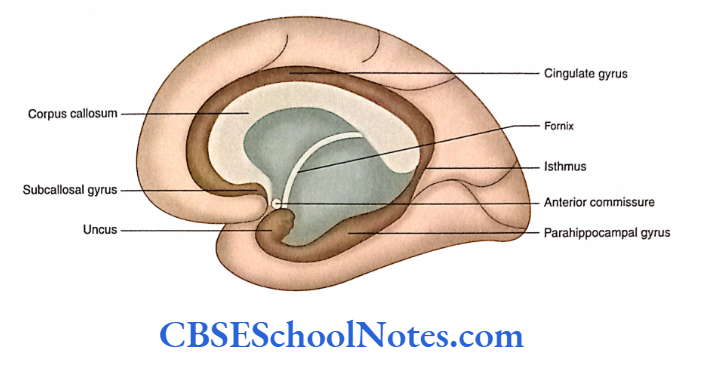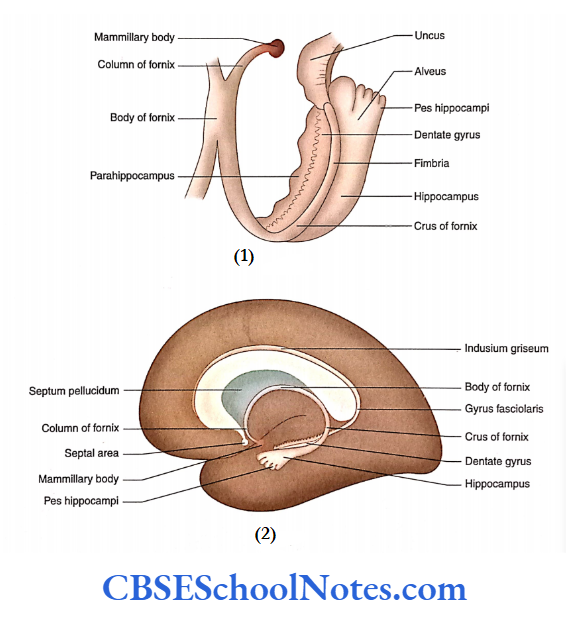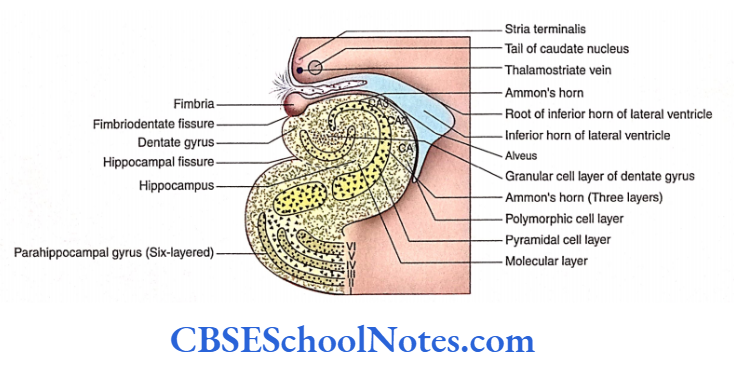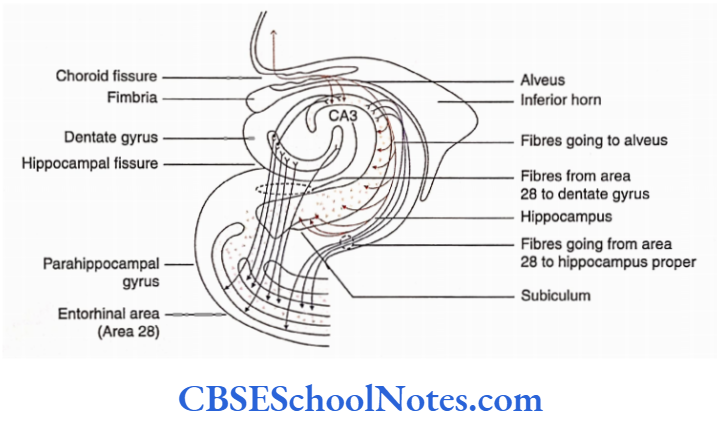Limbic System
The limbic system consists of several interconnecting nuclei and cortical structures in the telencephalon and diencephalon which form a ring-like structure around the upper end of the brainstem.
Functions Of The Limbic System
The limbic system is mainly concerned with emotions, visceral responses to emotions and memory.
The specific functions of the limbic system are as follows:
- Self-preservation: Procuring food, eating and identification of danger
- Species preservation: Sex and rearing of young ones
- Feeling of pleasures that are related to our survival such as those experienced from eating and sex
- Regulation of autonomic and endocrine functions
- Learning and retention of recent memory
Components Of The Limbic System
The limbic system consists of cortical regions, which include limbic lobe and hippocampal formation, and subcortical structures such as amygdala, septal nuclei, hypothalamus and thalamus.
Read and Learn More Neuroanatomy
Cortical Region Of The Limbic System
The cortical region of the limbic system consists of limbic lobe and hippocampal formation.
Limbic Lobe
- The term limbic lobe is used for the cortical structures that are in the form of a rim which surrounds the corpus callosum.
- The limbic lobe includes the orbitofrontal cortex, subcallosal, cingulate and parahippocampal gyri.
- These gyri encircle the upper part of the brainstem and corpus callosum on the medial surface of the cerebral hemisphere.
- The cortex of the limbic lobe has reciprocal connections with various subcortical nuclei of the limbic system.
Hippocampal Formation
The hippocampal formation consists of the hippocampus, dentate gyrus, subiculum, gyrus fasciolaris, indusium griseum and medial and lateral longitudinal striae.
Functions of Hippocampal Formation
- The most important function of hippocampus formation is the retention of information in short-term memory and its transfer into long-term memory.
- This allows the animal to compare the condition of a present threat with a similar experience in the past. This helps the animal in its survival.
- Through its connection with the septal area, hypothalamus and cingulate gyrus, the hippocampus influences emotion, endocrine and visceral functions.


Amnesia refers to loss of memory due to disease or trauma When both the hippocampi get destroyed, recent memory also gets lost.
However, long-term memory persists. This is because long-term memories are stored in various areas of the cerebral cortex.
Hippocampus
- Hippocampus is a longitudinal elevation, located in the entire length of the floor of the inferior horn of the lateral ventricle. Its anterior end is expanded and bears few ridges and grooves, resembling an animal’s foot.
- Hence, it is called pes hippocampi. When traced posteriorly, the hippocampus gradually narrows and ends below the splenium of the corpus callosum.
- The ventricular surface ofthe hippocampus is covered by a thin layer of white matter, known as an alveus.
- The alveus contains axons arising from the hippocampus and dentate gyrus. These fibres collect to form a bundle of fibres on the medial part of the hippocampus, known as fimbria. Posteriorly, fimbria continues as crus of fornix
Fornix
- Fornix consists of efferent fibres from the hippocampus. Each crus of fornix curves upwards behind the thalamus and two crura converge in midline to form the body of fornix.
- At the meeting point of two crura, decussation of fibres from two sides takes place which is known as hippocampal commissure.
- These fibres interconnect the hippocampi of the two sides. Anteriorly, the body of the fornix divides into two columns.
- Each column curves ventrally in front of the interventricular foramen and lies behind the anterior commissure. It then curves posteriorly to end in the mammillary body.
Dentate Gyrus
- The dentate gyrus is a narrow strip of grey matter. It bears a series of notches which give it a toothed appearance, hence the name dentate gyrus.
- When traced anteriorly, the dentate gyrus runs in the cleft of the uncus and then turns medially as the tail of the dentate gyrus. Posteriorly, it is continuous with gyrus fasciolaris.
Indusium Griseum and Longitudinal Striae
Indusium griseum is a thin layer of grey matter covering the upper surface of the corpus callosum. It is continuous posteriorly with the gyrus fasciolaris and anteriorly with the septal area.
Within the substance of the indusium griseum, two bundles of longitudinal running fibres are present on each of the midlines.
These fibres are called medial and lateral longitudinal striae. Both the indusium griseum and lateral longitudinal striae are hippocampal rudiments.
The large pyramidal cells in area CA1 of the hippocampus are highly sensitive to lack of oxygen and die within a few minutes.
The formation of new memory is concerned with involving area CA1 with the help of the phenomenon known as long-term potentiation.
Loss of memory and intellectual functions are severely affected if the pyramidal cells of the hippocampus are affected. This happens in a variety of conditions including Alzheimer’s disease.

Connections of Hippocampus
The connection of the hippocampus is illustrated.
Afferent Connections From the Entorhinal Area (Area 28)
- Hippocampal formation receives a variety of sensory information including olfaction because of its connections with the entorhinal area.
- In addition to the extrinsic connections between the entorhinal area and the hippocampus mentioned in the preceding text, intrinsic connections in the form of a closed circuit are also present.
- This circuit consists of the dentate gyrus to cornu ammonis (hippocampus) subiculum to the entorhinal area and back to the dentate gyrus.
Efferent Connections
The efferent fibres ofthe hippocampus form the fornix. Circuit of Papez (Hippocampal Circuit] The limbic system contains a ring (circuit) of interconnected neurons (nuclei). This circuit is depicted.
The Papez circuit interconnects the hippocampus with the hypothalamus (mammillary body through fornix), thalamus (anterior nucleus), cingulate gyrus and back to the hippocampus through cingulohippocampal fibres.


Subcortical Regions Of The Limbic System
The subcortical portions of the limbic system include the olfactory bulb, amygdala, septal nuclei, hypothalamus (mainly mammillary body), anterior nucleus of the thalamus, habenular nuclei, stria medullary thalami and midbrain reticular formation.
Amygdala
The amygdala is located near the temporal pole in the anterior part ofthe roof of the lateral ventricle.
The tail of the caudate nucleus is in contact with the amygdala in the roof of the inferior horn of the lateral ventricle.
Functions
The functions of the amygdaloid body are as follows:
- The amygdala part of the limbic system is considered to be most specifically involved with emotional experiences such as fear and anxiety.
- The emotional responses are processed in the amygdala.
- The amygdala can identify danger which is fundamental to self-preservation.
Connections
Afferent Connections
- From cortical areas: Orbitofrontal cortex, prepyriform and pyriform regions of the olfactory cortex, temporal lobe, cingulate gyrus and hippocampus.
- From the thalamus, hypothalamus and habenular nucleus
- From reticular formation.
Efferent Connections
The efferent fibres from the amygdala pass through the stria terminalis.
- To the temporal cortex and cingulate cortex,
- To reticular formation and
- To septal area and thalamus.
Stria Terminalis This begins from the posterior end of the amygdala. It is a bundle of white matter formed by efferent fibres from the amygdala.
At the interventricular foramen, most of its constituent fibres terminate in the septal area, preoptic area, anterior hypothalamus and stria medullaris thalami. The stria medullaris thalami fibres end in the habenular nuclei.

Damage to the amygdala in an experimental animal produces tameness (deprivation of affection and indifference to danger).
The PET and MRI studies have indicated that the amygdala is involved in the recognition of an emotional facial expression.
A patient with bilateral degeneration of the amygdala is not able to judge correctly the human facial expressions of sadness, happiness, surprise, fear, anger and disgust.
Septal Region
The septal region is present in front of the lamina terminalis beneath the genu and rostrum of the corpus callosum.
Septal nuclei lie deep in the cortex of the septal region. The septal region is continuous superiorly with the indusium griseum and inferiorly with the diagonal band and medial olfactory stria. The diagonal band connects the amygdaloid body with septal nuclei.
Functions
- Neuroendocrine and behavioural functions.
- Some consider the septal region a centre of orgasm.
Connections
Afferent Connections
Afferents come from amygdale, midbrain reticular formation and hippocampus
Efferent Connections
Efferents go to the hippocampus, reticular formation, habenular nuclei and cingulate gyrus.
Limbic System Summary
- The limbic system consists of many nuclei and cortical areas in the telencephalon and diencephalon which are interconnected with each other.
- The limbic system consists of cortical and subcortical structures. The cortical structures include the limbic lobe and hippocampal formation.
- The subcortical structures include the olfactory bulb, amygdala, septal nuclei, mammillary body, anterior nucleus of the thalamus, habenular nuclei, stria medullary thalami and midbrain reticular formation.
- The limbic lobe consists of the orbitofrontal cortex, subcallosal gyrus, cingulate gyrus, parahippocampus and uncus.
- Hippocampus formation consists of hippocampus, dentate gyrus, gyrus fasciolaris, indusium griseum and longitudinal striae.
- The hippocampus is a longitudinal elevation located on the floor of the inferior horn of the lateral ventricle.
- The fibres arising from the hippocampus pass through the alveus, fimbria and fornix.
- The dentate gyrus is a narrow strip of grey matter which bears a series of notches (appearing as teeth). Posteriorly, it is continuous with gyrus fasciolaris and then with indusium griseum.
- A coronal section passing through the inferior horn of the lateral ventricle also passes through the hippocampus, dentate gyrus, subiculum and parahippocampal gyrus.
- The subiculum is a transitional zone between the hippocampus (archicortex) and the parahippocampus (neocortex).
- There is a gradual change in the structure of the subiculum from four through five to a modified six-layered cortex.
- The fornix contains more than 1 million myelinated axons that originate from the pyramid cells of the hippocampus and subiculum.
- There, fibres are first collected in the alveus, then form the fimbria and ultimately the fornix.
- The amygdala is located near the temporal pole in the anteriormost part of the roof of the lateral ventricle close to the tail of the caudate nucleus. The stria terminalis is a bundle of white matter that consists of important efferent fibres of the amygdala.
- The cortex of the septal region is present in front of the lamina terminals beneath the genu and rostrum of the corpus callosum. The septal region is continuous with indusium griseum. It is connected with the medial olfactory stria and amygdala.
- Functionally, the limbic system is concerned with emotions, visceral response to emotions and recent memory.
Limbic System Multiple-Choice Questions
Question 1. The limbic system is concerned with the following functions except
- Conscious dissemination of taste
- Emotions
- Visceral response to emotions
- Memory
Answer: 1. Conscious dissemination of taste
Question 2. Which of the following cortical areas are included in the limbic lobe?
- Orbitofrontal cortex
- Subcallosal gyrus
- Cingulate gyrus
- Parahippocampal gyrus
- All of the above
Answer: 5. All of the above
Question 3. Which of the following subcortical areas are included in the limbic system?
- Olfactory bulb
- Amygdala
- Mammillary body
- Anterior nucleus of the thalamus
- All of the above
Answer: 5. All of the above
Question 4. The fibres of stria terminalis terminate in the following regions except
- Septal area
- Preoptic area
- Anterior hypothalamus
- Habenular nuclei
- Anterior thalamus
Answer: 3. Anterior hypothalamus
Question 5. Following are the components of hippocampal formation except
- Hippocampus
- Dentate gyrus
- Subiculum
- Gyrus fascioliasis
- Septal area
Answer: 3. Subiculum
Question 6. Following are the functions of hippocampal formation except
- Formation of long-term memory
- Retention of recent memory
- Transfer of short-term memory into long-term memory
- Compares the condition of the present threat with a similar experience
Answer: 1. Formation of long-term memory
